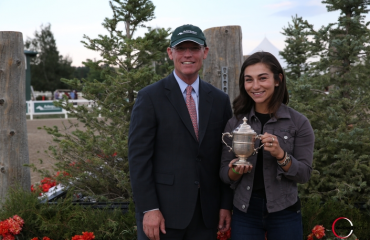
Boyd Martin riding Gloria Callen’s mare Welcome Shadow
Photo by Amber Heintzberger
Well known for both his fun-loving approach to life and his indefatigable work ethic, Boyd Martin has represented the U.S.A. in three-day eventing at two Olympic Games and two World Championships, and was on the gold-medal-winning Pan Am Games team in 2015. Boyd’s wife, Silva Martin, is a grand prix dressage rider and they have a son, Nox. Boyd and Silva train out of their own farm, Windurra USA in Cochranville, Pennsylvania, and spend winters at Stable View Farm in Aiken, South Carolina.
How do you incorporate learning from your peers at the top level of the sport?
The sport of eventing is always changing, and I know I sound old, but I’ve been riding around four-stars for nearly 20 years now. Thinking back to my first two-star in 2000, there’s a remarkable difference in the preparation we do for the horses now. I think one of the most important things as an event horse trainer is to always be looking for new ideas and new techniques. The goal posts are always changing, not only in riding but in training techniques. Everyone has their own system and way of doing things and I think you should always be trying to improve the way you do things.
This year I’ve been lucky to cross paths with Felix Vogg, who represents Switzerland at the Olympic and World Championship level but lives and trains in Germany and has been under Michael Jung’s tutelage for the past eight years. Felix has based his horses here in America this year with the idea of having the ideal preparation for the WEG later this year in Tryon. I’ve become good pals with him in Aiken and now he’s at our farm in Pennsylvania, and not a day goes by that I’m not quizzing him about his training and fitness program and the way he rides and cares for his horses.
I’d say the bulk of the training is similar: it’s a lot of hard work that goes into preparing a horse for the four-star level and I believe there’s no way around this. He definitely has put some fresh, new ideas in my mind, one of which is the dressage training. He said a lot of the event horses in Germany do a great deal of their training on the side of a grass hill. Not only does this freshen their mind but it strengthens the hind end and teaches them balance. When I showed him our facilities in Pennsylvania, he thought our cross-country field is perfect for this type of schooling.
It’s also been interesting watching Felix work out of his comfort zone. I’ve quietly watched Phillip Dutton coach Felix on his three-star horse a number of times and I must tip my hat to him for recognizing the brilliance of another master; he said he’s learned a tremendous amount from Phillip while he’s been here in America.
At the end of the day, we’re all trying to get better, from four-star professional riders trying to make a team to adult amateurs trying to get around the lower levels. There’s no set way of doing things: each horse and rider are individuals and we must streamline our training to what suits both horse and rider and their unique character.
What has influenced your horses’ fitness programs?
Since coming to America, the person that I’ve learnt most from fitness-wise is undoubtedly Phillip Dutton. Phillip has a solid plan for each horse mainly taught to him by racing legend Michael Dickinson, and it’s a similar fitness program that Michael would use for his National Hunt and Steeplechase horses back in England.
One of the most awesome things about being in the heart of the Chester County hunt country is that there are a number of legendary horse trainers, from show jumpers, dressage and eventers to racehorse trainers and jockeys. Throughout the winter, I shared a stable with Maryland Hunt Cup winner Mark Beecher. Mark is a good mate of mine from Ireland, and he’s not only America’s leading timber rider but also a top trainer of timber racing horses. It’s been awesome stabling alongside Mark at Stable View and I picked up a number of tools that he uses to keep his horses fit.
We’re lucky to be located near Maui Meadows swimming facility in Pennsylvania. This was built for racehorses; in 2006 Phillip encouraged me to bring Ying Yang Yo there to get him fit for Rolex when he had bruised feet because it was a good way to get him fit without putting any weight on his feet. A number of trainers like Paddy Young, Bruce Miller and Bruce Davidson also use the facilities and I realized quickly that swimming makes the horses work very hard without putting any pressure on their lower limbs and it also definitely makes the horse breathe in a very deep way, really working the lungs. I don’t use it as a replacement for galloping; preparing for Kentucky, we gallop every five days and swim them a few days after they gallop. It’s just a bit of extra work and a different sort of fitness to galloping. I like to think when I turn up to these big international events there’s a bit of comfort, mentally, turning up with a very well-conditioned horse.













